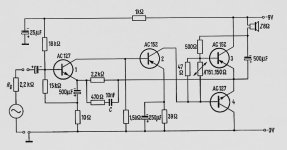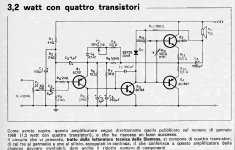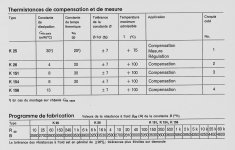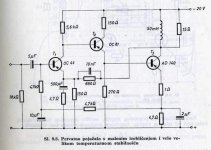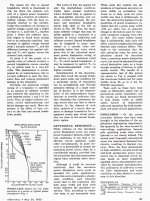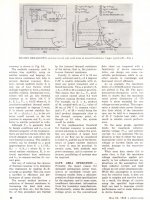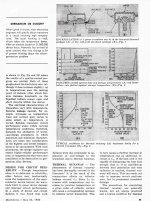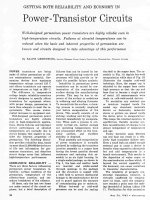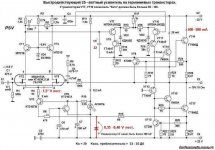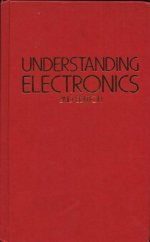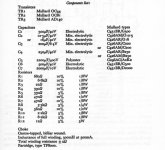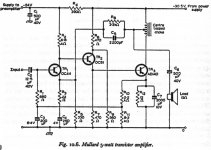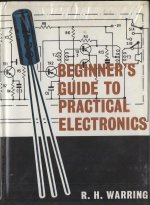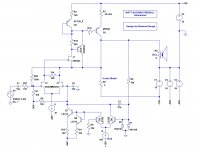The first scheme is standard in Europe in the 70s (Philips, Siemens, ...) 0,5- 8 w.
The second, at one time underestimated original circuit with the current principle of controlling the output transistors. The original implementation of the GNFB.
The second, at one time underestimated original circuit with the current principle of controlling the output transistors. The original implementation of the GNFB.
Last edited:
@ Old Diy
On the left first version by Siemens 1.2 watts 100 % pure Germanium flea amplifier.
La version 3,4 watts are interesting as well and can work with 12V car batterys :^)
Edit : K151 component is a thermistor
( information source are from old Siemens catalogue in French language )
On the left first version by Siemens 1.2 watts 100 % pure Germanium flea amplifier.
La version 3,4 watts are interesting as well and can work with 12V car batterys :^)
Edit : K151 component is a thermistor
( information source are from old Siemens catalogue in French language )
Attachments
Hi
I made some measurements with Ge buffer
(I put in the original topic
.
The Kuartlotron - keantoken's simple error-correction superbuffer
.
I made some measurements with Ge buffer
(I put in the original topic
.
The Kuartlotron - keantoken's simple error-correction superbuffer
.
Today I p2p aseembled "JLH Buffer" with 2SK246/2SJ103 and GT402ZH/GT404ZH.
No matching. First channel had 38mV output DC with no load. Tested with earphone, it's working. Then I measured the other one, which was -132mV output DC, so I added 220R resistor in parallel to existing 220R, and voila, both of them have 38mV DC out. As I am using these to drive another capacitor coupled stage, I won't attempt to get lower DC. Soundwise, I cannot tell yet the difference from Mosfet source follower I used in exact link of soundchain, because I cannot fully enjoy it at the moment (not a good time for it). I predict it to be different sound than mosfet follie tho. I'll hear later.
And those resistors were a tad toasted, but I could't find another ones, sorry.
could You please send the schematc?
It is this one Another jfet buffer
Except I used 220 ohm instead of 330R and also different j-Fets and Ge BJTs.
Except I used 220 ohm instead of 330R and also different j-Fets and Ge BJTs.
Is there such a thing as a currently available, still in production Ge device for consideration in a power amp?
@ Twichie
Only vintage transistors, nothing new and still in production.
Last batch was made in USSR/Russia in the 90's.
You get choices NOS parts are available..
for example 2SB206 Germanium investigations
and many others :^)
Only vintage transistors, nothing new and still in production.
Last batch was made in USSR/Russia in the 90's.
You get choices NOS parts are available..
for example 2SB206 Germanium investigations
and many others :^)
Look at this all vintage GE packages and data scheets
download link: https://ia800607.us.archive.org/27/items/TransistorHandbook/Transistor Handbook.pdf
source: Transistor Handbook : Free Download, Borrow, and Streaming : Internet Archive
Nice thanks to Archive.org
download link: https://ia800607.us.archive.org/27/items/TransistorHandbook/Transistor Handbook.pdf
source: Transistor Handbook : Free Download, Borrow, and Streaming : Internet Archive
Nice thanks to Archive.org
Attachments
Is there such a thing as a currently available, still in production Ge device for consideration in a power amp?
In the countries of the Eastern bloc, germanium devices were developed and manufactured until the early 1990s.
There and developed the most powerful and high quality.
Currently, they are not produced, but there are very large stocks of "military purpose". Large reserves, because they do not contain precious metals. But there is a lack of modern specific circuitry suitable for Ge.
Pages of an article : Important parameters for reliable Ge circuits design. 

Attachments
Protective VT9 and VT13 silicon, with low saturation voltage collector-emitter. You can't do without them.
The diode, marked in red, is pulsed, at low power.
Its role is to turn off the servo at high output current.
The input microassembly of JFET is also silicon. All other transistors are germanium.
The diode, marked in red, is pulsed, at low power.
Its role is to turn off the servo at high output current.
The input microassembly of JFET is also silicon. All other transistors are germanium.
Public domain old book with Ge amplifiers schematics
download link : https://ia801007.us.archive.org/2/items/understandingelectronics/UnderstandingElectronics.pdf
source: Understanding Electronics : R.H. Warring : Free Download, Borrow, and Streaming : Internet Archive
download link : https://ia801007.us.archive.org/2/items/understandingelectronics/UnderstandingElectronics.pdf
source: Understanding Electronics : R.H. Warring : Free Download, Borrow, and Streaming : Internet Archive
Attachments
..The input microassembly of JFET is also silicon. All other transistors are germanium.
I like this first jfets stage and after all germaniums 😀
5 watts Müllard circuit with choke is minimalistic,
I guess can be loud together with 16 Ohms Altec or TAD compression driver & horns
download link: https://ia801007.us.archive.org/9/items/bgtopracelectronics/BGtoPracElectronics.pdf
Beginner's Guide to Practical Electronics : R.H. Warring : Free Download, Borrow, and Streaming : Internet Archive
Attachments
Very interesting design from one of my favorite ing-s Kirkwood Rough. Link from this site:
Watt Sucking Fireball Series
.
Seems like very powerfull Ge device?
https://pccomponents.com/datasheets/MOTO--MP500.pdf
Watt Sucking Fireball Series
.
Seems like very powerfull Ge device?
https://pccomponents.com/datasheets/MOTO--MP500.pdf
Attachments
Last edited:
On the page 133 chapter " Class A Output Stages " Mullard e-book year1960.
Some have tube driver and Ge power output
http://www.introni.it/pdf/Mullard - Reference Manual of Transistor Circuits 1960.pdf
Some have tube driver and Ge power output
http://www.introni.it/pdf/Mullard - Reference Manual of Transistor Circuits 1960.pdf
Attachments
- Home
- Amplifiers
- Pass Labs
- Germanium investigations
